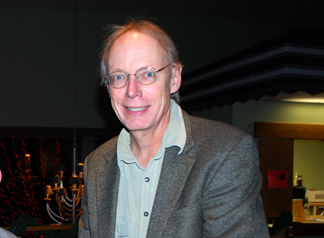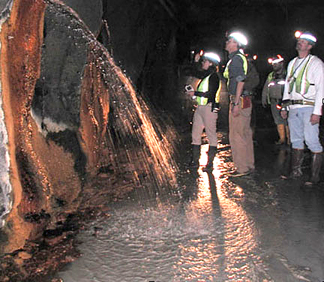Tech Biology Prof Co-Authors Paper Reassessing Quantity of Living Material On Earth
October 23, 3018
Dr. Tom Kieft studies microbial life in extreme environments of Earth’s deep subsurface
SOCORRO, N.M. – New Mexico Tech professor Dr. Tom Kieft is a co-author on a new paper in Nature Geoscience that suggests the amount of living material on Earth is twice what was previously thought.
Kieft contributed previously unpublished data collected in deep gold mines in South Africa, which he has collected over 15 research expeditions since 1998. The paper, titled “The Biomass and Biodiversity of the Continental Subsurface,” is the first comprehensive compilation of decades of data about the mass of bacteria that live in the Earth’s subsurface. The paper is in the October 2018 issue of Nature Geoscience.
 Kieft has visited several working gold mines, including areas 3.8 kilometers below
the surface. He also was involved in discussions with the first author about the general
approach to analyzing data related to organic carbon concentrations in the subsurface
and the environmental parameters and controlling factors that influence the habitability
of microbes deep in the subsurface.
Kieft has visited several working gold mines, including areas 3.8 kilometers below
the surface. He also was involved in discussions with the first author about the general
approach to analyzing data related to organic carbon concentrations in the subsurface
and the environmental parameters and controlling factors that influence the habitability
of microbes deep in the subsurface.
“We have found that microbes are getting energy from hydrogen,” he said. “Hydrogen is generated geochemically by various interactions between water and rock. H2 is a great energy source and there are microbes that can get energy from hydrogen and use it to make organic carbon. These ecosystems aren’t based on photosynthesis; they are based on chemosynthesis.”
Recent studies suggest that the deep biosphere is a substantial reservoir of novel, yet uncultured, microbial phyla that have significant implications for the evolution of Earthbound life. Both the size and diversity of the Earth’s subsurface biosphere and its evolutionary history have direct implications for the search for extant or extinct life on Mars and other planetary bodies.
Dr. Cara Magnabosco of Princeton University pulled together the data for the paper, which had been gathered over more than 20 years by her former advisor and co-author Dr. Tullis C. Onstott, also of Princeton.
 “The interest in trying to quantify the number of microbes in the Earth really started
about 20 years ago,” Kieft said. “The subsurface is the least accessible. It’s been
only a few decades that we’ve been looking at the subsurface and we’ve been going
deeper.”
“The interest in trying to quantify the number of microbes in the Earth really started
about 20 years ago,” Kieft said. “The subsurface is the least accessible. It’s been
only a few decades that we’ve been looking at the subsurface and we’ve been going
deeper.”
(Pictured at right: Dr. Tom Kieft and colleagues collect samples at a borehole in a South African mine.)
Onstott, Kieft, Magnabosco, and a growing number of scientists from around the world have been collecting samples and quantifying the abundance of living organisms, as well as characterizing the habitats in which microbes thrive. The latest paper shows that the number of microbes could be an order of magnitude greater than previously thought – 5.5 x 10^30 cells, as opposed to previously accepted estimate of 2.9 x 10^30.
“This unseen world – no one had really looked at until 25 to 30 years ago,” Kieft said. “It was thought that the subsurface was sterile and wasn’t worth studying. But now we can show that there’s a significant portion of the Earth’s microbes down there – and the Earth’s biomass and the Earth’s carbon.”
In addition to compiling decades of data, the authors also applied new theories about the conditions in which microbes thrive, specifically depth, temperature, rock type, organic carbon, and other parameters that could be major controlling factors.
This publication comes at an opportune time – with a series of meetings on the topic later this month in China. Kieft said one of the upshots of the paper is that scientists will have new ideas about where to conduct more studies of the subsurface.
“There are missing pieces,” Kieft said. “There are whole continents that we don’t know about – or for which we can only estimate abundance and diversity based on environmental parameters such s depth and rock type. This is an important new synthesis and this kind of comprehensive analysis may help us see where the holes are.”
– NMT –